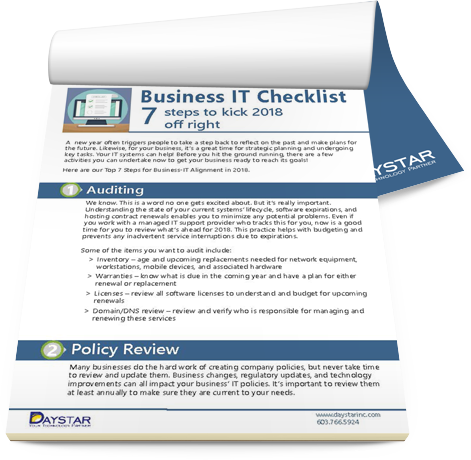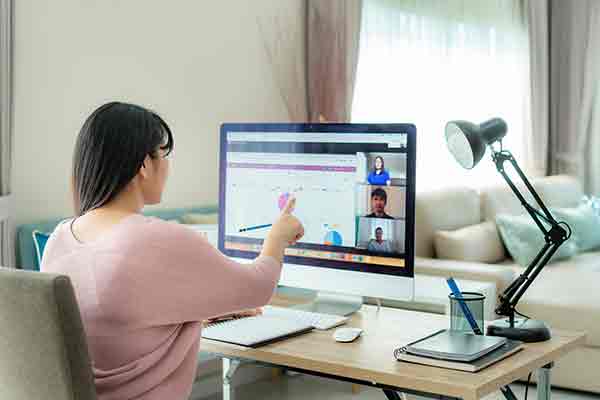The last three months have universally impacted us all in some way. From a business perspective, some industries were affected more severely than others, but all experienced some sort of change. We saw many of our clients quickly roll out remote set-ups for office staff. Others made physical changes to their manufacturing floors or health care offices to ensure safety. The impact is unlike anything we have experienced and won’t leave us once a vaccine is found.
 The most visual change is the empty offices and the rise of video conference meetings as lots of people began to Zoom about as they worked remotely. Video conferencing isn’t new, but many small businesses didn’t utilize it as much since in-person communication was easy and considered preferable to a screen. Once the ability to meet in the conference room disappeared, video conferencing became a necessity. After the initial scramble to learn the nuances of online meetings, many businesses found some distinct advantages.
The most visual change is the empty offices and the rise of video conference meetings as lots of people began to Zoom about as they worked remotely. Video conferencing isn’t new, but many small businesses didn’t utilize it as much since in-person communication was easy and considered preferable to a screen. Once the ability to meet in the conference room disappeared, video conferencing became a necessity. After the initial scramble to learn the nuances of online meetings, many businesses found some distinct advantages.
We use Microsoft Teams, a full-fledged collaboration platform. Teams has powerful video conferencing capabilities that scale easily from one-on-one meetings to small groups to larger meetings for up to 250 people. As Microsoft 365 users, we love the tie-in Teams has with Outlook and other Office apps. We can set up meetings on the fly through the app or even via Outlook.
Prior to going remote, we primarily used Teams’ collaboration tools within our physical office environment – chat messaging, real-time file collaboration, and communication across team channels. Once the majority of our team began to work from home, we incorporated more video conferencing immediately. It is not uncommon for me to have three or four video meetings per day. Some may be a quick ten minute huddle with another colleague, while others are longer department meetings with half-dozen people. And, once a week, our entire Daystar team comes together to close the week out and check in with each other in a more informal way.
We believe the pandemic will have real and permanent changes to the way we work. It has created and continues to create new challenges for businesses. Still, we see businesses rise up and use technology in some awesome and creative ways to overcome those challenges. Here are some of the changes we see.
The Hybrid Office
For many businesses that went remote, going back to the office likely won’t be the same as before. A phased reopening process, new physical space requirements, employee needs or reluctance, and newly realized efficiencies will all play a factor in how businesses “come back” together.
In many cases, we will see a hybrid office environment, blending onsite and remote work to create a safer environment and more fluid efficiency. As people have been forced to become more accustomed to remote work, the divide between onsite and offsite team members is becoming less pronounced. How this works will differ according to a particular organization’s needs, butsome of the ways you might see this include:
- A Days and B Days with cleaning in between where one set of employees is scheduled in the office on A and remote on B, and a second set doing the opposite.
- Remote and Onsite team members: usually based upon role or job function, some employees are designated remote workers, while others (e.g. production floor workers) are designated onsite workers.
- Staggered working hours: to reduce the number of people in a physical office at the same time, some companies may choose to implement shifts of staggered working hours.
As a business implements new models, it is really critical to document your new process and add it to your employee handbook. In addition, when implementing long-term remote workers, we highly recommend a detailed remote work policy.
Traditional Business Operations - in a New Way
Another change we have seen is the challenges the current environment created for traditional business processes. For many of us, business did not stop over the past three months; it shifted. Using technology, we learned new ways of getting business done.
Customer Relationship and Consulting
For those in high-touch consulting arenas like financial, legal, technology, and professional services, staying connected to customers became a challenge. In-person meetings to conduct strategic planning or expert guidance had to be re-imagined. At Daystar, for example, our virtual Chief Information Officer (D-CIO) shifted all of his business technology alignment visits to a virtual platform using Microsoft Team’s video conferencing, whiteboarding, and screen sharing tools. With the inherent security of Microsoft Teams, we were able to accomplish this both seamlessly and securely.
In the future, we expect that we will see some sort of combination of in-person and online meetings, to ease scheduling headaches, allow more stakeholders to attend, or lessen the need for travel.
Business Development
B2B sales teams were also challenged with social distancing limitations. Much of the sales process is relationship-building and networking. Since no new business is not an option, business development teams needed to find new ways to connect. Our business development team relied on new capabilities within our existing CRM and online meetings again with Microsoft Teams to connect with prospects and meet with our networking partners.
How easy it was to shift relationship-building to a virtual platform surprised even us. Business professionals are so much more comfortable with video conferencing now and the ease and speed in which you can set up a meeting makes it extremely efficient.
Customer Service/Support
The area of customer service and support is going to be different for every business because it must be tailored to your own situation, whether it be a support desk, an order processing team, etc. It needs to tie into any line-of-business software you might use, as well as your communication and collaboration platforms.
Our Help Desk team went fully remote in March. All of our internal applications were already securely set up for remote access so our focus was on creating new department procedures to help the team work together seamlessly in a distributed work environment. Daily huddles, video conferencing, chat messaging, and check-ins replaced the physical “Tech Row” where we could stand up and talk over the cubicle wall. Our new, virtual tech row succeeded beyond our expectations, earning a whopping 98.5% CSAT score from submitted client reviews since we went fully remote on March 17.
So, what have we learned? Working in an industry where, if you don’t embrace change, you die, the question of what we learned and where we go from here is crucial. Like many other businesses, we are making changes to the status quo and will continue to do so. The last three months have challenged us, surprised us, and reaffirmed our faith in the resiliency of our team and our clients.
Want to learn more about Microsoft Teams? We can set you up with a free Teams demo. Contact us today to learn more.
Daystar is a managed IT services provider and business technology integrator serving businesses and organizations in the tri-state area throughout New Hampshire, Maine, and Massachusetts.















